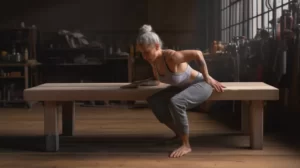Tight shoulders, rounded shoulders, stiffness, and pain are common ailments that can lead to a limited range of motion. It’s important to address these issues to maintain an active and pain-free lifestyle. One effective way to do this is through yoga, with a focus on poses aimed at releasing shoulder tension and strengthening the muscles in the shoulders. In this article, we’ll look at one excellent yoga pose – downward-facing dog – in two different variations to specifically target shoulder pain and stiffness.
Downward-Facing Dog (Chair-Assisted)
Chair-assisted downward-facing dog is a great variation for those who may have difficulty with balance or issues with hand or wrist pain. Here are the steps for this variation:
- Start by placing your hands on the back of a chair, fingers wide open.
- Walk back as you extend your arms completely and stop when you are fully extended.
- Walk your feet back until they are stacked under your hips; just far enough so you can support your balance while pressing your weight down through your feet into the floor.
- Press your hands down onto the chair and your knees back to engage your thighs. You want a slight bend in your knees so your quadriceps engage and strengthen.
- Stretch your chin away from the chest, crown of the heads forward.
- Press the shoulders down but do not let the ribcage drop. Instead, bring it in toward the body. Pull your navel to your spine. By doing this, you engage the upper and lower parts of the scapula, or shoulder.
- Hold for a few nice, easy breaths to allow the shoulders to open up. When finished, slowly walk your feet back to the chair to raise your body back to an upright position.
Downward-Facing Dog (Full)
The full version of downward-facing dog has the same elements as the chair-assisted version, but is done on the floor. To perform this version, follow these steps:
- Begin by getting down on all fours with your hands under your shoulders and your knees under your hips.
- Spread your fingers for a wider hand base and move onto the balls of your feet.
- Press your hips up and extend your arms to create an A-frame posture.
- Adjust your posture to achieve a long spine by either slowly walking your hands forward or stepping your feet backward. Try to keep your legs as straight as possible.
- Press down through your heels to engage your thighs, and press down on your palms and shoulders while raising your ribs and pulling your navel in toward your spine.
- Take a few breaths and relax into the posture.
- When you are done, come up onto your toes, drop down to your knees, and relax into Child’s Pose. After a few moments, sit up and enjoy the benefits of your practice.
Tips for Healthy Shoulders
Aside from practicing the downward-facing dog and its variations, here are some other tips for maintaining healthy shoulders and preventing pain and stiffness:
- Be mindful of your posture throughout the day, especially when sitting for extended periods. Keep your shoulders relaxed, pulled back, and down.
- Incorporate shoulder stretches into your daily routine. Some examples include chest openers, neck rolls, and arm circles.
- Strengthen your shoulder muscles with exercises such as push-ups, shoulder presses, and rows. Aim to do these exercises two to three times a week for best results.
- Be aware of any lifestyle habits that may be contributing to shoulder pain, such as carrying a heavy purse or frequently using a smartphone. Make adjustments as necessary to reduce unnecessary strain and pressure on your shoulders.
In conclusion, maintaining shoulder health is crucial to overall mobility and comfort. The downward-facing dog and its variations, along with other tips for healthy shoulders, can help to alleviate shoulder pain, stiffness, and tension, allowing you to continue participating in the activities you enjoy. So take the time to work on your shoulder health, and reap the benefits of increased mobility and strength.



